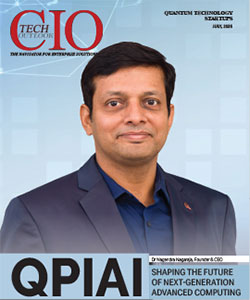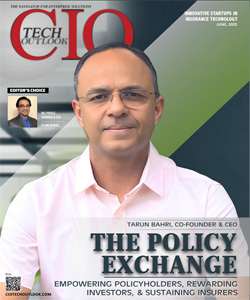AI-Powered Due Diligence: Transforming Private Markets Intelligence
Tonmoy Shingal, Co-Founder and CEO, Binocs
 Tonmoy Shingal, Co-Founder and CEO of Binocs, in an interview with CIOTechOutlook, discussed how Generative AI is transforming due diligence and financial analysis in private markets. He discussed agentic-AI's importance and how it will reduce the layers of steps in the investment workflow, make reliance on data reliable, and allow for ongoing real-time analysis. Tonmoy discussed how AI-driven solutions are bridging the information gap between public and private market intelligence to give investors better, faster, and significantly less biased information.
Tonmoy Shingal, Co-Founder and CEO of Binocs, in an interview with CIOTechOutlook, discussed how Generative AI is transforming due diligence and financial analysis in private markets. He discussed agentic-AI's importance and how it will reduce the layers of steps in the investment workflow, make reliance on data reliable, and allow for ongoing real-time analysis. Tonmoy discussed how AI-driven solutions are bridging the information gap between public and private market intelligence to give investors better, faster, and significantly less biased information.
Tonmoy has extensive experience in academia and industry as an expert in applying AI to financial innovation. Tonmoy is a graduate of IIT Kanpur and IIM Bangalore. He is the Co-Founder and CEO of Binocs, where he is building agentic-AI solutions to automate the due diligence process. As an active angel investor, Tonmoy's investments in over 60 startups span SaaS, fintech and AI.
With the ability to analyze vast datasets in real time, how does AI enhance the speed and depth of due diligence in private equity or venture capital decisions?
Traditionally, deep analysis has been required in the venture capital and private equity industry. Artificial Intelligence, especially Generative AI, provides tools that enhance the infrastructure necessary to perform tasks previously handled by experienced human teams. By leveraging LLMs and Gen AI systems, those tasks that were previously complex and non-repeatable, and typically within the domain of private equity and venture capital professionals, can be done more quickly. The flexibility of LLMs and Gen AI provides the opportunity to create agents that can be customized and instantiated in a manner that closely replicates the operations of a human team.
As AI reshapes risk profiling and predictive analytics, how is this transformation influencing investor confidence in opaque private markets?
Investors have been less confident in private markets primarily because of the quality, depth, and format of the available data. In public markets, the data is more structured and readily available; at the same time, in private markets, the data is often unstructured, inconsistent, and hard to access. This led to dramatically more difficulty in searching and analyzing information in private markets and leading to concern about the reliability of investment decisions in the private market space.
The emergence of Generative AI and Large Language Models (LLMs) has created a capacity to efficiently process and create structured information in the right framework. These technologies can extract, organize, and analyze complex data sets to create structured information for the purpose of detailed analysis. Investors can now bridge the gaps between public and private market environments with the assistance of these tools.
Given the fragmented nature of private market data, how does AI bridge the information gap to support more informed and unbiased investment decisions?
Limited data is a primary challenge in private markets. Information is often distributed across numerous sources and presented in formats that are difficult to read, interpret, or standardize. This is where Gen AI or Large Language Model (LLM)-based agents can offer tremendous value. These agents scan large amounts of unstructured data, including web resources that are not defined and cannot be retrieved in a systematic way. With millions of websites and portals available, the ability to efficiently scan and extract relevant data is critical.
Gen AI can parse publicly available web data and, where permitted, access content within walled gardens or behind private firewalls. Data fragmentation is reduced by leveraging tools that can take intelligent agents and consolidate and synthesize scattered information into coherent, actionable insights, leading the way to provide investors with data to make more comprehensive, unbiased decisions.
AI tools are now capable of detecting early signals of financial or operational red flags—how is this changing the role of human analysts in the due diligence process?
More private equity funds and alternative investors are looking at ways to automate financial analysis and detect early warning signals. With the advancement of AI tools and the deployment of sophisticated models, much of this financial analysis and early warning signal detection can be automated. Instead of several days compiling data and accumulating, generating insights, analysts can now rely on Gen AI tools to produce detailed, high-quality reports within minutes. It leaves the analyst with the role of reviewing the report, validating the key points, understanding things more deeply, and supplementing with additional analysis when required. This shift has dramatically increased the speed, breadth, and depth with which funds can access and act on analytical insights.
In the context of regulatory compliance and ESG assessments, how does AI-driven due diligence bring rigor and speed to monitoring obligations?
Private equity (PE) funds and venture capital (VC) investors face challenges in evaluating a company’s compliance practices. A lot of relevant information is often embedded in annual reports, where auditors may include notes and comments regarding the company’s compliance practices. There are also opportunities to find information from non-financial information included in the company’s annual reports or regulatory filings. Because the agents used in this case are programmed to read the annual report from start to finish in the same amount of time it takes a human, but at an exponentially faster speed, the agents can read thousands of reports in a single command. As a result, the ability of investors to monitor compliance and ESG practices across their portfolio companies has significantly improved.
As private markets continue to grow in complexity and volume, how critical is AI in ensuring continuous, real-time due diligence beyond the deal-making stage?
There are several trends likely to take shape over the next few years that will have a major impact on the industry. One such trend is in the private equity space, because there are tens of thousands of funds, and a significant number of venture capital funds, as well. Currently, the industry has the most funds at a high level, followed by a lot of mid-tier funds. These large funds, owing to their access to significant capital, can secure the best deals. This leaves a gap between large and mid-tier funds. Another emerging factor is the adoption of generative AI by various teams to support their decision-making. The use of generative AI will no longer be optional; it will become a basic requirement.
The transformation brought by AI in private markets intelligence is still unfolding - what emerging trends or technologies are poised to further disrupt traditional due diligence models?
Generative AI is widely utilized today, one such advance is the fundamental concept of agents, which provides more intelligent ways to perform tasks. In terms of team structure, agents act as domain specialists, executing specific aspects of complex processes such as due diligence with greater efficiency. The primary goal of the industry at present is to enhance the function and output of those kinds of agents. There are many new infrastructure layers built on top of established infrastructure that are driving this transformation. All these types of agents will fundamentally shape the future of the industry.




